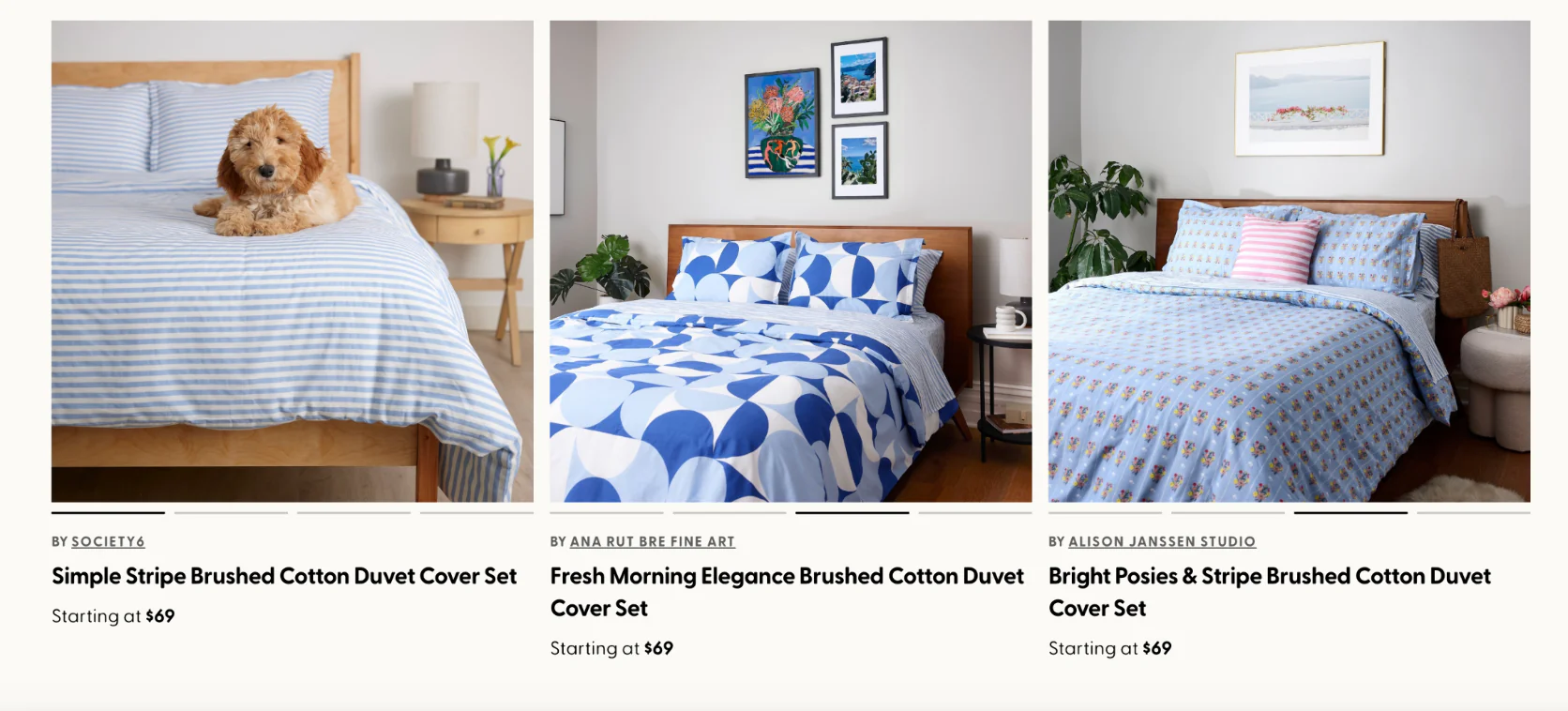Learn how Society6's VP of eCommerce reduced choice overload through strategic curation. Discover 5 proven strategies to boost conversions, reduce cart abandonment, and improve customer loyalty through better product selection.
July 14, 2025
"Less Is More": How Strategic Curation Beats Customer Decision Fatigue and Boosts Sales
More options = mean more sales, right? While this holds true for some businesses, many retailers find the opposite. Too much choice overwhelms customers, creating decision fatigue that makes it harder to complete purchases.
In this article, Brit Tucker, VP of eCommerce & Technology at home decor retailer Society6, shares five key strategies to help retailers boost conversions by simplifying customer experience.
Five Choice Management Strategies
- Quality Over Quantity: Narrow your catalog to showcase only your best, most on-brand products.
- Speak Your Customers' Language: Translate product details and your expertise into simple, relatable language that helps buyers feel confident—especially for products that require a bit of education.
- Strategic Merchandising: Use behavioral data to personalize recommendations.
- Test Everything: When reducing choice, it’s even more important to test what stays, what goes, and how you present it.
- Listen Actively: Pay close attention to customer feedback across all touchpoints to continuously refine your curated selection and personalization efforts.
Why Retailers Should Address Choice Overload
Reducing choice isn’t about limiting the customer—it’s about guiding them. And when done right, tackling choice overload can improve multiple business-critical metrics:
- Increased conversion rates: When shoppers quickly find products that match their tastes, they’re far more likely to purchase more often.
- Fewer abandoned searches: Massive catalogs can overwhelm even the most motivated buyer. A curated selection reduces friction, helping customers commit instead of clicking away.
- Stronger customer loyalty: Personalized, curated experiences showcase your expertise. When you help customers choose well, they see you as a trusted advisor.
- Better operational efficiency: Managing a huge catalog creates technical challenges and content overload. Curation streamlines workflows across merchandising, development, and support.
For retailers looking to elevate both experience and performance, curated simplicity could be a powerful differentiator.
Strategies for Moving from Overwhelming to Curated and Personalized
Based on Brit's experience, here are practical strategies retailers can use to create more effective shopping experiences:
This strategic approach to catalog reduction isn't about limiting choice---it's about elevating quality.
1. Prioritize Quality Over Quantity
Customer feedback helps you find the right balance between variety and quality. If you’re tracking website behavior and notice high bounce rates on category pages, weak PDP Views, or low Add to Cart rates, these are signals that there is likely a discovery challenge for your customers.
Your catalog should feel carefully curated, not chaotic.
This is especially critical when selling unique products. A home decor retailer needs to showcase only the highest-quality artwork that truly captures their brand’s design vision.
Your catalog should feel carefully curated, not chaotic.
This is especially critical when selling unique products. A home decor retailer needs to showcase only the highest-quality artwork that truly captures their brand’s design vision.
Implementation tips:
- Regularly audit your catalog to identify underperformers—and analyze why they're missing the mark.
- Develop clear criteria for product selection that align with your brand identity.
- Highlight products that offer something distinct—something competitors don’t.
2. Speak Your Customer’s Language
Building a shared language with your customers is critical, especially when your products require context or expertise to understand.
In home decor, customers have a hard time articulating their style preferences. Words like 'modern, ' 'antique, ' or 'vintage' mean different things to different people. Visuals become essential to the customer journey so they can see exactly what we mean by 'vintage.'
Customers are looking for inspiration—not specs. Lifestyle photography and creator collaborations showing products in real homes help them imagine these items in their spaces.
Customers are looking for inspiration—not specs. Lifestyle photography and creator collaborations showing products in real homes help them imagine these items in their spaces.

Lifestyle photography help customers make a choice without articulating their preferences
Implementation tips:
- Develop language that bridges the gap between industry terms and customer understanding.
- Translate abstract descriptions into relatable examples (e.g. “8-hour battery life” instead of “5,000 mAh”)
- Use real-life scenarios to show how products solve specific problems.
- Whenever possible, show products in context—not just in isolation.
3. Merchandise Strategically with Your Curated Selection
A more focused catalog opens the door to smarter, more personalized merchandising. With a curated assortment, you can build meaningful, relevant journeys for each customer.
I’ve found that personalization becomes much more manageable with a focused catalog. You can ensure that follow-up touchpoints show relevant products rather than generic recommendations.
In my team, we analyze everything from purchase patterns to artist engagement. If a shopper is browsing retro mid-century prints in a specific color palette, recommendations reflect that exact aesthetic.
Implementation tips:
- Segment customers by style preferences and browsing behavior.
- Identify frequently purchased combinations to surface in-cart recommendations.
- Build curated collections based on real usage patterns.
- Start collecting preferences early.
4. Test Everything, Especially "Best Practices"
Instead of following trends blindly, Brit advocates for a test-and-learn approach to make sure what works for others actually works for your customers.
I encourage my teams to fail. If they’re not failing, they’re not running challenging enough tests to really learn what works—and what doesn’t. We need to know both.
My favorite testing example comes from one of my previous retail experiences. We were considering hiding desktop navigation behind hamburger menus to showcase more imagery—a common move at the time. But our A/B tests showed it tanked conversions. Our customers relied on the traditional navigation menus. That taught me a huge lesson: always test before following trends.
Implementation tips:
- Test different aspects of your user experience, from navigation structures to page layouts.
- Try different filtering and sorting designs.
- Experiment with recommendation logic tailored to your catalog
- Don’t shy away from testing unexpected or contradictory ideas—sometimes showing fewer products drives more sales.
5. Listen to Your Customers
Gathering and responding to customer feedback is essential for effective curation and personalization. The best product strategy doesn’t start with guesses—it starts with conversations.
Create an environment where everyone who engages with customers can gather actionable feedback and insights.
Have your social team track how customers actually use products in real life. Send post-purchase and post-shipping surveys. Let your designers run usability tests. Then bring all this information together to understand what’s really working and what needs improvement
This constant feedback loop helps ensure your curated catalog reflects what customers actually want—not just what you think they want.
Implementation tips:
- Build feedback checkpoints into every customer touchpoint.
- Centralize insights so all departments can learn from them.
- Set up fast, simple workflows for acting on feedback to improve your curation.
Conclusion: Better Relationships Through Better Curation
Brit's experience demonstrates that tighter curation doesn't limit your brand---it strengthens it. By focusing on relevance, quality, and intentional design, you create more space for connection, not less.
This approach ensures you’re building stronger customer relationships. By carefully curating your catalog, you’re responding directly to customer feedback and showcasing products that truly represent your brand’s design point of view.
It’s about quality of experience, not quantity of options.
For retailers looking to stand out in saturated markets, the message is clear: less can be more—especially when “less” means clearer navigation, more meaningful recommendations, and a brand experience that respects your customer’s time and attention.
Struggling with choice overload in your e-commerce strategy? Maestra’s marketing automation platform helps retailers create curated, personalized customer experiences that boost conversions and reduce decision fatigue.
Book a demo today to see how our platform can transform your approach to product merchandising and deliver measurable ROI across all customer touchpoints.

